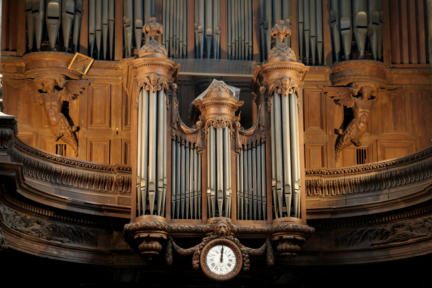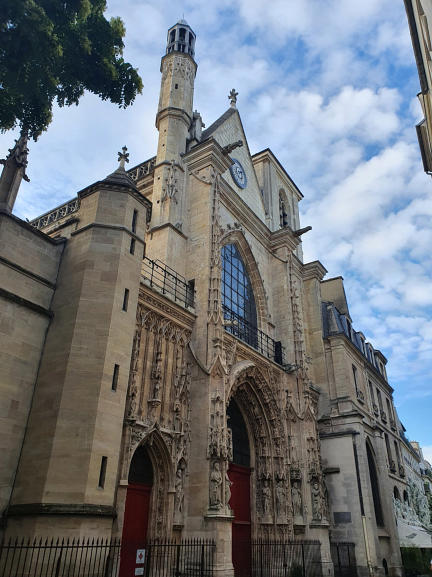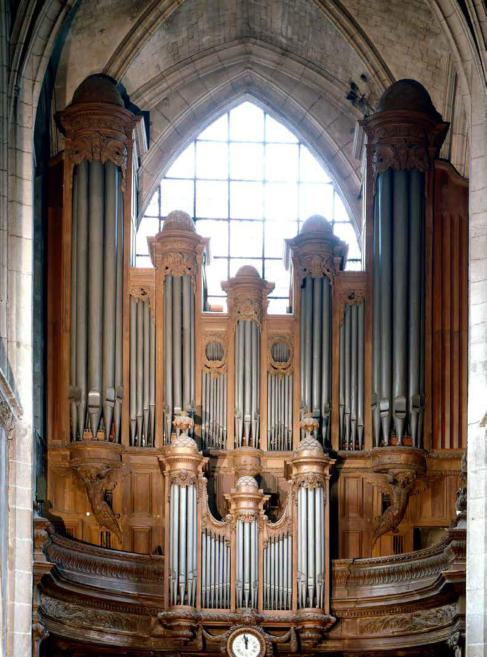


ORGANS OF PARIS © 2024 Vincent Hildebrandt HOME ALL ORGANS


St-Merry was built between 1510 and 1552 in a
flamboyant Gothic style, replcing earlier churches,
dating back to the 7th century. In the 18th century,
some renovations were carried out in a baroque
style. The bell tower contains the oldest bell in
Paris, cast in 1331.
The church has the same layout as Notre-Dame
cathedrals: the length of the choir is almost the
same as the length of the nave, hence its nickname
"Small Notre-Dame". The stained glass windows of
the nave dates back to the 16th century.

E6
From the middle of the sixteenth century, the church had an
instrument placed on a small gallery, at the end of the south
cross.
1647
In 1647, faced with the dilapidation of the instrument, it was
decided to build a new instrument on a large platform. The
construction of the case was entrusted to Germain Pilon
and the instrument was made by the organbuilders Jean
and François De Héman, probably using parts of the earlier
organ. During the construction of the instrument, initially in
8', it was transformed into a 16'. At that time, the
instrument had 35 stops on three manuals and pedalboard.
1664
Etienne Enoch redid the bellows, softened the reeds, and
added a 4' flute to the pedalboard. He equipped the
instrument with a fourth half-manual for a Cornet on the
Récit.
1669
Overhaul by François Ducastel and Pierre Baillon. The
keyboards were increased to 50 notes, and an 8' Trumpet
was added to the Récit.
1719/1736
Nicolas Collard did an overhaul, added a few stops,
including a 4' Clairon to the Pedal and redid the wind tunnel.
1755
The sculptor Michelangelo Slodtz and his brother Sebastian-
Antony, who had been entrusted with the embellishment of
the church, enlarged the gallery and modified the Positif
from behind.
1778-1782
François-Henri Clicquot rebuilt and enlarged the instrument.
During the revolutionary period, the instrument escaped
looting but suffered from the saltpeter stored in the church.
In 1796, the organist Desprez had the case repaired. In
1799, shortly before his death, Claude-François Clicquot
restored the organ.
1816
Pierre-François Dallery did an overhaul and restored the
Pleins-Jeux that had disappeared.
1854-1857
The organ was rebuilt by Aristide Cavaillé-Coll who reused a
large part of the old materials.
1917-1922
Electrification of the wind tunnel in 1917 and partial
overhaul in 1922 by John Abbey.
1947
Victor Gonzalez was tasked with carrying out a "hybrid"
restoration, adding new stops. He gave the organ a classical
face while preserving the contributions of Cavaillé-Coll.
Subsequently, the instrument was transformed many times
by the Gonzalez House according to the evolution of the
"neo-classical organ" movement.
1999-2000
Dargassies restored the Barker machine, the wind tunnel,
added a new power supply and carried out restoration work
on the piping.
This work remained inadequate. In 2023, the organ went
almost silent.
A substantial part of the piping still dates from before the
revolution. The windchests of the GO and the Positif are still
from Clicquot. The 16' GO Montre tch and the 8' GO
Trumpet date back to the 17th century. The majority of the
principals, flutes and reeds are also by Clicquot.

Organiste titulaire
Jean-Marc Leblanc - Stéphane Béchy
Famous organists in the past: Nicolas Lebégue (1630-
1702), Jean-François Dandrieu (1681-1738) et Camille
Saint-Saëns (1835-1921), Norbert Dufourq (1923-1990).
Concerts
Seldomly
Masses with organ
Saturday 6.30 PM Sunday 10 AM
Videos
3 Noëls français (Bechy)
Böhm Praeludium und fuge C-dur (Litaize)
Improvisation sur un noël (Marie-Claire Alain, disque
Erato)
Improvisation sur Il est né le divin enfant
(Marie-Claire Alain, disque Erato)
Presentation of the organ after the transformation of
Victor Gonzalez (1942-47) by André Marchal (organ) and
Norbert Dufourcq (explications). (Enregistrement EMI
repris par ERATO Novembre 1973)
All organs built before the revolution
Photo buffet: Orgues en France

In the plan to maintain the cultural heritage of the City
of Paris, this organ is among the four prestigious and
emblematic instruments, classified as Historic
Monuments, requiring a fundamental restoration.
Restoration issues
Inside a beautiful 1651 buffet, the work of carpenter-
sculptor Germain Pilon, several of the most famous
organ builders succeeded the original creators, the De
Heman Brothers, as early as the 17th century. From
that time on, the organ was profoundly transformed
by François-Henri Clicquot (1778-82), then by Aristide
Cavaillé-Coll (1854-57) and Victor Gonzalez (1942-47).
At each period, the organ is rebuilt under the
influence of organists to make it fit to serve new
music.
Enriched with new stops, the instrument features 64
stops inside a buffet originally designed for 35, making
it the densest organ in Paris but the most difficult to
maintain. In the 1950s, it became the perfect example
of the "neo-classical" organ, a springboard for
renewed interest in organ music and for the
emergence of a new musical aesthetic carried by
composers such as Vierne, Tournemire, Dupré, Fleury,
Duruflé, Langlais, Alain, Grunenwald, Litaize,
Messiaen, all of whom played the organ.
If everyone agrees on the point of de-densifying the
instrument, the question has been asked as to which
state to return it? The National Commission of Historic
Monuments selected the scenario of the return to the
state "Gonzalez" of 1947 out of the 8 restoration
scenarios identified by Roland Galtier, technician-
counsel of the State. The challenge is to sublimate the
idea of 18th-century sounds in 1945, retaining new
sounds that serve 20th-century composers.
Operation Call to Patronage Programme: 2.060.000
euros, exclusive the costs associated with the project
management, which will be borne by the City of Paris.
Source


1647 - Jean et François De Héman (1)
1664 - Etienne Enchoch (2)
1669 - François Ducastel & Pierre Baillon (6)
1719/36 - Nicolas Collard (6)
1778/82 - François-Henri Clicquot (3a)
1816 - Pierre-François Dallery (6)
1857 - Aristide Cavaillé-Coll (3a)
1917/22 - John Abbey (6)
1947 - Victor Gonzalez (3a)
2000 - Bernard Dargassies (6)
IV/64 (58) -
traction mécanique (claviers)
electrical (jeux)
composition

Photo below: Jeroen de Haan
The organs of Paris
ORGANS OF PARIS © 2024 Vincent Hildebrandt ALL ORGANS
E6
From the middle of the sixteenth century, the church had an
instrument placed on a small gallery, at the end of the south
cross.
1647
In 1647, faced with the dilapidation of the instrument, it was
decided to build a new instrument on a large platform. The
construction of the case was entrusted to Germain Pilon and
the instrument was made by the organbuilders Jean and
François De Héman, probably using parts of the earlier
organ. During the construction of the instrument, initially in
8', it was transformed into a 16'. At that time, the instrument
had 35 stops on three manuals and pedalboard.
1664
Etienne Enoch redid the bellows, softened the reeds, and
added a 4' flute to the pedalboard. He equipped the
instrument with a fourth half-manual for a Cornet on the
Récit.
1669
Overhaul by François Ducastel and Pierre Baillon. The
keyboards were increased to 50 notes, and an 8' Trumpet
was added to the Récit.
1719/1736
Nicolas Collard did an overhaul, added a few stops, including
a 4' Clairon to the Pedal and redid the wind tunnel.
1755
The sculptor Michelangelo Slodtz and his brother Sebastian-
Antony, who had been entrusted with the embellishment of
the church, enlarged the gallery and modified the Positif
from behind.
1778-1782
François-Henri Clicquot rebuilt and enlarged the instrument.
During the revolutionary period, the instrument escaped
looting but suffered from the saltpeter stored in the church.
In 1796, the organist Desprez had the case repaired. In 1799,
shortly before his death, Claude-François Clicquot restored
the organ.
1816
Pierre-François Dallery did an overhaul and restored the
Pleins-Jeux that had disappeared.
1854-1857
The organ was rebuilt by Aristide Cavaillé-Coll who reused a
large part of the old materials.
1917-1922
Electrification of the wind tunnel in 1917 and partial overhaul
in 1922 by John Abbey.
1947
Victor Gonzalez was tasked with carrying out a "hybrid"
restoration, adding new stops. He gave the organ a classical
face while preserving the contributions of Cavaillé-Coll.
Subsequently, the instrument was transformed many times
by the Gonzalez House according to the evolution of the
"neo-classical organ" movement.
1999-2000
Dargassies restored the Barker machine, the wind tunnel,
added a new power supply and carried out restoration work
on the piping.
This work remained inadequate. In 2023, the organ went
almost silent.
A substantial part of the piping still dates from before the
revolution. The windchests of the GO and the Positif are still
from Clicquot. The 16' GO Montre tch and the 8' GO Trumpet
date back to the 17th century. The majority of the principals,
flutes and reeds are also by Clicquot.
Organiste titulaire
Jean-Marc Leblanc - Stéphane Béchy
Famous organists in the past: Nicolas Lebégue (1630-1702),
Jean-François Dandrieu (1681-1738) et Camille Saint-Saëns
(1835-1921), Norbert Dufourq (1923-1990).
Concerts
Seldomly
Masses with organ
Saturday 6.30 PM Sunday 10 AM
Videos
3 Noëls français (Bechy)
Böhm Praeludium und fuge C-dur (Litaize)
Improvisation sur un noël (Marie-Claire Alain, disque Erato)
Improvisation sur Il est né le divin enfant
(Marie-Claire Alain, disque Erato)
Presentation of the organ after the transformation of Victor
Gonzalez (1942-47) by André Marchal (organ) and Norbert
Dufourcq (explications). (Enregistrement EMI repris par ERATO
Novembre 1973)
All organs built before the revolution
Photo buffet: Orgues en France
1647 - Jean et François De Héman (1)
1664 - Etienne Enchoch (2)
1669 - François Ducastel & Pierre Baillon (6)
1719/36 - Nicolas Collard (6)
1778/82 - François-Henri Clicquot (3a)
1816 - Pierre-François Dallery (6)
1857 - Aristide Cavaillé-Coll (3a)
1917/22 - John Abbey (6)
1947 - Victor Gonzalez (3a)
2000 - Bernard Dargassies (6)
IV/64 (58) -
traction mécanique (claviers)
electrical (jeux)
composition























